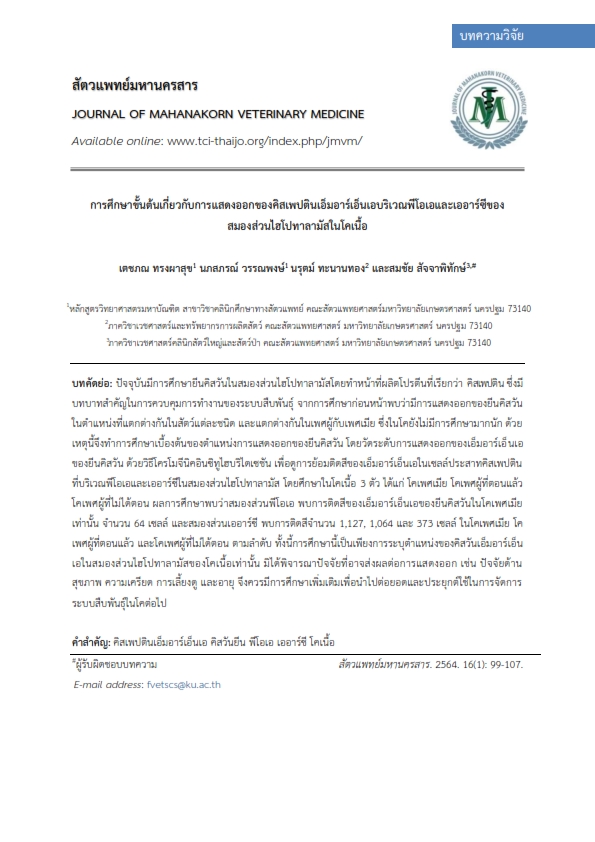Preliminary Study of Kisspeptin mRNA-expressing Neurons at POA and ARC in Hypothalamus of Beef Cattle
Main Article Content
Abstract
At present, there are more studies about the Kiss1 gene in the hypothalamus that produce the kisspeptin proteins and have an important role in the reproductive system. The previous research found the location of expression of Kiss1 gene is different about each species and sex. But, there are a few studies about the location of Kiss1 gene in cattle. Therefore, the objective of this study was a preliminary study to localize Kiss1 mRNA expression in the area of POA and ARC nucleus in the hypothalamus. By used a chromogenic in situ hybridization staining for Kiss1 gene in the cattle brain revealed that kisspeptin neuronal populations were localized in the POA and ARC of the hypothalamus. This study used three cattle brains including one female, one castrated male, and one intact male. And the result showed that the expression of kisspeptin mRNA-positive cells in the POA was about 64 cells that only expressed in female cattle. And the expression of kisspeptin mRNA-positive cells in the ARC were 1,127, 1,064, and 373 in female, castrated male, and intact male cattle respectively. However, this study is only to specify the location of kisspeptin mRNA in cattle brains, without considering the factors that may affect the expression of kisspeptin mRNA including, health status, stress-induced, management and age. Therefore, further studies are required for developing and applying to reproductive management in cattle.
Article Details

This work is licensed under a Creative Commons Attribution-NonCommercial-NoDerivatives 4.0 International License.
References
ABCAM. 2001. In Situ Hybridization Protocol.
Bates , P. J., G. Sanderson, S. T. Holgate, S. L. Johnston. 1997. A comparison of RT-PCR, in-situ hybridisation and in-situ RT-PCR for the detection of rhinovirus infection in paraffin sections. J. Virol. Methods. 67: 153–160.
Chaikhun-Marcou, T., P. Sotthibandhu, V. Kyle, S. H. Yeo, W. H. Colledge, and S. Suadsong. 2016.Evidence of kisspeptin receptor expression in GnRH neurons in the preoptic area and arcuate hypothalamic nuclei in cycling buffaloes. Thai J. Vet. Med. 46(3): 381-390.
Chaikhun, T., P. Sotthibandhu, and S. Suadsong. 2013. The Role of Kisspeptin Signaling in Reproduction of Ruminants. Thai J. Vet. Med. 43(1): 7-14.
Daniel, J. A., C. D. Foradori, B. K. Whitlock, and J. L. Sartin. 2015. Reproduction and Beyond, Kisspeptin in Ruminants. J. Anim. Sci. Biotechnol. 6(1): 23.
d'Anglemont de Tassigny, X., and W. H. Colledge. 2010. The role of kisspeptin signaling in reproduction. Physiology (Bethesda). 25(4): 207-217.
Dungan, H. M., D. K. Clifton, and R. A. Steiner. 2006. Minireview: Kisspeptin Neurons as Central Processors in the Regulation of Gonadotropin - Releasing Hormone Secretion. Endocrinology. 147(3): 1154–1158.
Moore, A. M., L. M. Coolen, D. T. Porter, R. L. Goodman, and M. N. Lehman. 2018. KNDy Cells Revisited. Endocrinology 159(August): 3219–3234.
Okamura, H. 2002. Brain atlas of cattle. Tokyo.
Pinilla, L., E. Aguilar, C. Dieguez, R. P. Millar, and M. Tena-Sempere. 2012. Kisspeptins and reproduction: physiological roles and regulatory mechanisms. Physiol. Rev. 92(3): 1235-1316.
Sajapitak, S., I. Fhaikruae, P. Bussabong, K. Pakkarano, T. Tiwanon, H. Markshom, and N. Thanantong. 2014. A Pilot Study of Kisspeptin Neurons in a Hypothalamus Area in Swamp Buffalo. J. Kasetsart Vet. 24(3): 117-126.
Sajapitak, S., P. Lertwatcharasarakul, S. Phattanakunanan, P. Moonjit, and N. Thanantong. 2016. Preliminary Study of Kisspeptin Neurons in the ARC of the Hypothalamus in Beef Cattle. J. Kasetsart Vet. 26(1): 24-33.
Salehi, M. S. 2013. A simple method for isolation of the anteroventral periventricular and arcuate nuclei of the rat hypothalamus. Anatomy (International Journal of Experimental and Clinical Anatomy). 6-7: 48-51.
Smith, J. T., Q. Li, A. Pereira, and I. J. Clarke. 2009. Kisspeptin neurons in the ovine arcuate nucleus and preoptic area are involved in the preovulatory luteinizing hormone surge. Endocrinology. 150(12): 5530-5538.


